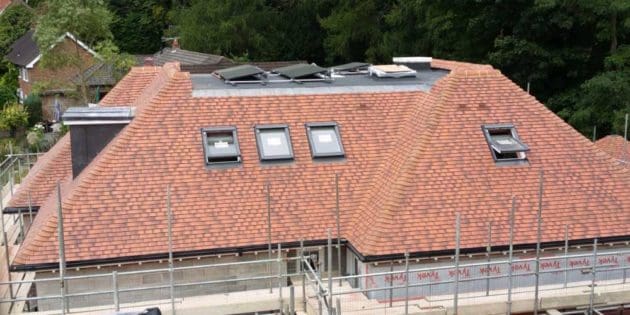
Pitched Roofing
The fundamental design of a roof can have a massive impact on the aesthetics, function, and value of a property. If you’re considering a new roof for your home or business premises, you’ll face the decision of choosing between a flat and pitched roof. Both types of roof offer advantages and disadvantages, so here we’ll explore pitched roofing a little more, so you have the details you need to make an informed decision.
The Advantages of Pitched Roofing
A pitched roof is the traditional roofing solution for domestic properties and is still a popular choice today for various reasons. One of the most obvious is the versatility offered. While a flat roof may be built to cope with foot traffic, a pitched roof can be converted to offer substantial additional living space inside the home. You can design playrooms, storage, attic bedrooms, offices and more under a pitched roof. This versatility is invaluable for creating more room inside your property and potentially increasing the resale value and future buyer appeal.
Pitched roofing is also well regarded for offering great durability and longevity. Whereas a flat roof may require significant maintenance, this is less of a focus for a pitched roof. Flat roofing typically requires hands on attention to ensure optimum performance for as long as possible. When you have a large area of roofing, this can be a discouraging prospect. Pitched roofs offers better drainage potential as water can be naturally channelled into guttering and downpipes to be removed from your home. This means that there is less of a risk of pooling water, which is vital in certain areas. Flat roofing tends to have drainage issues, particularly if you live in an area with prolonged or heavy rainfall.
The Potential Disadvantages
While maintenance may be less of an issue compared to flat roofing, the initial cost of a pitched roof is far higher. Although it should never be the primary decision factor, price is always a consideration on any renovation project. Additionally, a pitched roof will take more time to install, which can affect other areas of the project. For example, business owners may prefer the reduced disruption offered by a flat roof, while homeowners may need to wait to finish off other areas of a renovation until the roof has been installed and is watertight. The time intensive nature of installing a pitched roof can be problematic if there are severe time constraints on a project deadline. A flat roof can be installed quickly, and the materials tend to be far cheaper, which reduces the overall costs involved in the project. However, once the roof is in place, pitched roofing does tend to be less problematic and require less maintenance.
Both flat and pitched roofing can create unique visual appeal for your property. Both roofing styles can be created with a variety of materials to increase lifespan and minimise maintenance issues. If you’re unsure whether your property would benefit from a pitched roof, you should speak to us. Our recommended experienced roofing professionals have expertise in the installation, repair, and maintenance of both pitched and flat roofing. The team would be delighted to answer any queries you may have.
Need a Roofer?
Popular Local Roofers
Need a Roofer?
Recent Reviews About The Roofers
Overall Rating:
Based on 510 reviews
Was good value for money, done work when said very efficient would recommend
Jayne
just had my roof done new felt / battens chimney removed,new ridge by a very professional crew of 5 everything done to a high standard. i would recommend mano lee with out hesitation.
stephen dobbins
The roof of a flat we own was letting in water. Contacted roofcare Swansea, Manrica came up the same day and with in 2 days the roof was stripped, new under sheet and tiles relayed.
Garry
Prompt & courteous response with sound advice. Will use C R S Roofing for any other future needs.
Kenny MacKenzie
Thanks for completing the flat roof job on friday. It was done to an exceptionally good standard… My husband is very satisfied with it and all the dealings with you have been very professional. Thank you again.
Leah
Our home was in need of roofing replacement. We were very happy with the complete job and follow up by the team at Better Choice Roofing. We have gotten a lot of compliments from neighbors and even passerby on the appearance and quality.
Monica
Better Choice Roofing did an amazing job replacing my roof and gutters. They were responsive, communicative, professional, price matched another estimate I had gotten, and got the job done in a timely manner. I highly recommend this company!
Toni
They did a great job! Very responsive and knowledgeable! Installed my roof and gutters. They were wonderful to work with!
Aaron
I had my garage re roofed by Fred and they were brilliant. They were very professional from start to finish and the garage roof is now watertight and looks amazing. Fred have done other work near me and it all stands the test of time.
Joseph
My Trusted Expert Guarantee
Experts Have Been Vetted & Approved